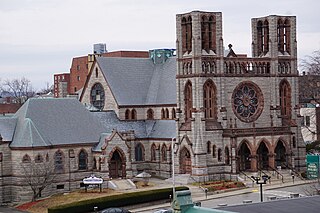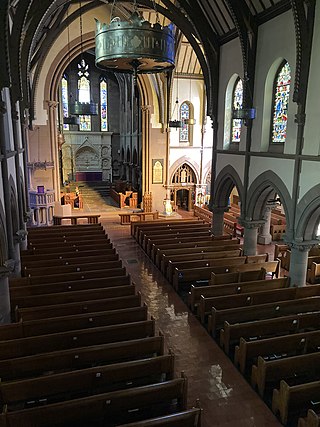Robert Cary Long Jr. (1810–1849) was the son of a late 18th Century - early 19th Century famous architect Robert Cary Long Sr. of Baltimore, Maryland and was himself a well-known 19th Century architect. Like his father, Cary was based in Baltimore.
Henry C. Dudley (1813–1894), known also as Henry Dudley, was an English-born North American architect, known for his Gothic Revival churches. He was a founding member of the American Institute of Architects and designed a large number of churches, among them Saint Paul's Episcopal Cathedral in Syracuse, New York, built in 1884, and Trinity Church, completed in 1858.

The Church of the Incarnation built in 1896 is a historic Carpenter Gothic Episcopal church building located at 111 North 5th Street in Highlands, Macon County, North Carolina.

Union Episcopal Church, also known as the English Church, is a historic church located on Old Church Road in Claremont, New Hampshire, in the United States. Built in 1773, it is the oldest surviving Episcopal church building in New Hampshire and is also the state's oldest surviving building built exclusively for religious purposes. It is still an active parish in the Episcopal Diocese of New Hampshire. On February 1, 1980, it was added to the National Register of Historic Places.

The Union Congregational Church or Chestnut Street Congregational Church is a historic Congregational church building at 5 Chestnut Street in Worcester, Massachusetts. The church is a well-preserved local example of Victorian Gothic Revival styling. Its basic appearance is reminiscent of the Notre Dame de Paris, although on a more modest scale. The building was designed by Earle & Fisher and construction took place between 1895 and 1897. Its main facade features twin towers flanking an entrance consisting of three trefoil arches, above which is a large rose window and an arched arcade connecting the two towers. The upper levels of the towers are open areas surrounded by paired narrow pointed-arch openings, and are decorated by crenellations and gargoyles. The main body of the church is covered in a slate roof, and the stained glass of some of its windows was brought over from the buildings of other church congregations which merged into the Union congregation.

St. John's Protestant Episcopal Church is an historic church located at 628 Main Street in Stamford, Connecticut. The church is an English Gothic Revival structure, built in 1891 to a design by William Potter. It has buttressed stone construction, with a compound-arch entry and a large rose stained-glass window. The associated parish house, also a Gothic Victorian structure, was designed by Richard M. Upjohn and built in 1869–72.

The Methodist-Episcopal Church, also known as the Stannard-Greensboro Bend Methodist Church, is a historic church in Stannard, Vermont. Built in 1888, it is one of the small town's few 19th-century public buildings, and a good example vernacular Victorian architecture. It was listed on the National Register of Historic Places in 1978.

Holy Trinity Episcopal Church also known as Holy Trinity Memorial Church is an historic Episcopal church building located at 38 Grand Avenue in the village of Swanton, Franklin County, Vermont. Built in 1876 and expanded in 1909-10, the church facilities include a fine example of the Carpenter Gothic in the older section, and the Late Victorian Gothic Revival in the newer section. The church was listed on the National Register of Historic Places as the Parish of the Holy Trinity in 2001. The church is an active parish in the Episcopal Diocese of Vermont; its current rector is the Rev. Reid D. Farrell.

St. Paul's Episcopal Church is a historic church building at Bridge Street and Vermont Route 14 in Royalton, Vermont. Built in 1836, it is a prominent early example of Gothic Revival architecture in the state, and is one of the oldest surviving public buildings in Royalton's historic village center. Now deconsecrated and maintained by the Royalton Historical Society, it was listed on the National Register of Historic Places in 2001.

St. Thomas Episcopal Church is a historic Episcopal church building located at 2720 Slaterville Road, east of the post office in Slaterville Springs in the town of Caroline, Tompkins County, New York. It was built in 1893 and is an example of the Carpenter Gothic style of architecture, sometimes called the High Victorian Gothic. It features include, a steeply sloped roof, lancet windows, lancet covered entry through a side steepled belfry, all of which are typical of the Carpenter Gothic style.

The Metropolitan African Methodist Episcopal Zion Church is a historic Methodist Episcopal Church at 2051 Main Street in Hartford, Connecticut. This High Victorian Gothic structure was built in 1873-74 for an Episcopal congregation, and has since 1926 been the home to the city's oldest African-American congregation, which was established in 1833. The church was listed on the National Register of Historic Places in 1994.

St. Peter's Episcopal Church is a historic Episcopal church building at 31 Throckmorton Street in Freehold Borough, Monmouth County, New Jersey, United States.
This is a list of the properties and historic districts in Stamford, Connecticut that are listed on the National Register of Historic Places. The locations of National Register properties and districts for which the latitude and longitude coordinates are included below, may be seen in an online map.
Charles E. Choate was a U.S. architect who worked in Georgia, Florida, and Alabama. He designed numerous buildings that are listed on the U.S. National Register of Historic Places.
Grace Episcopal Church is a historic Episcopal church building is located at 210 C Avenue, South, in Minnewaukan, Benson County, North Dakota.

Grace Episcopal Church is an historic Episcopal church building located at 405 2nd Avenue, North East, in Jamestown, Stutsman County, North Dakota. Designed in the Late Gothic Revival style of architecture by British-born Fargo architect George Hancock, it was built 1884 of local fieldstone exterior walls and a wooden roof. Early parish records contain several assertions that George Hancock modeled the church after Christ Episcopal Church which had been opened in 1881, but if he did, it was only in a very general, not specific way. Hancock's later work St. Stephen's Episcopal Church is much more closely related to Christ Church, Medway. On December 3, 1992, Grace Episcopal Church was added to the National Register of Historic Places.
Grace Episcopal Church is an historic Episcopal church building located at 152 Ramsey Street, West in Pembina, Pembina County, North Dakota. Designed in the Late Gothic Revival style of architecture by Fargo architect George Hancock, it was built in 1886. Unlike all the other churches in the Episcopal Churches of North Dakota Multiple Property Submission (MPS), it was built of brick instead of local fieldstone. The brick is yellow and was made locally by the Pembina Brick Company. The church building is one of only three extant building built of this brick. In 1937 Grace Church closed due to declining attendance and the building was sold by the Episcopal Diocese of North Dakota to the local Methodist congregation. Today it is the Pembina Pioneer Memorial United Methodist Church. On September 2, 1994, the building was added to the National Register of Historic Places as Grace Episcopal Church.

The United Unitarian and Universalist Church in Mukwonago, Wisconsin is a Victorian Gothic-styled church and meeting hall built in 1878 - the only Yankee-built church remaining in the town. In 1987 it was added to the National Register of Historic Places for its significance in architecture and social history.

The Goddard United Methodist Church formerly the Dodson Avenue Methodist Episcopal Church, is a historic church at 1922 Dodson Avenue in Fort Smith, Arkansas. The church building is an imposing Late Gothic stone structure, built in 1930 to a design by the local architectural firm of Haralson and Nelson. The congregation for which it was built was founded in 1908, and worshipped in a wood-frame church at this site prior to the construction of the present edifice. In October 1945 the church was renamed the Goddard Memorial Methodist Church in honor of a recent pastor, Dr. O. E. Goddard. The church complex includes, in addition to the church, a children's building, fellowship hall, and office building.

The Downtown Churches Historic District is a historic district in downtown Sheboygan, Wisconsin consisting of four churches and five other buildings associated with the churches. The four churches which comprise the district are Grace Episcopal Church, built in the High Victorian Gothic style in 1871; First Methodist Episcopal Church, built in 1929–30 in the Late Gothic style; Hope Reformed Church, built in 1937 in the Late Gothic style; and St. Martin Lutheran Church, built in 1968 in a contemporary style. The churches serve as historical examples of a century's worth of religious architecture spanning four different faiths and a variety of styles. In addition, the first Boy Scout troop in Wisconsin was founded in Grace Episcopal Church in 1911. The district was added to the National Register of Historic Places on March 1, 2010.















